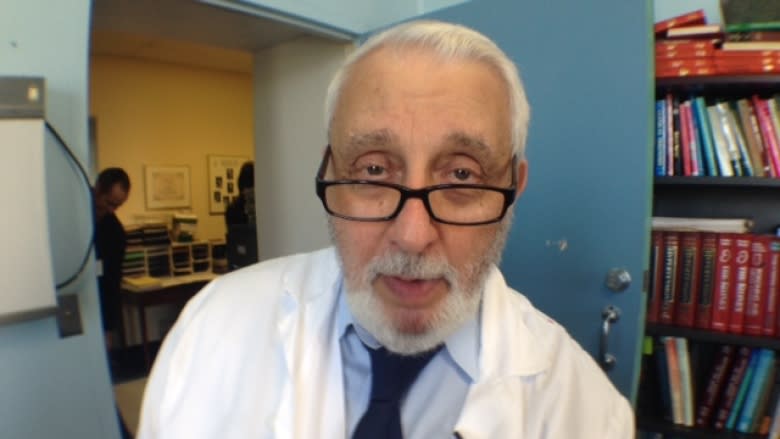Giant 1950s-era artificial kidney to be preserved at new MUHC
An enormous artificial kidney from the 1950s — perhaps the last of its kind in existence — will be preserved as Montreal’s 122-year-old Royal Victoria Hospital prepares to move all its patients and facilities to the new McGill University Health Centre's Glen campus in April.
The kidney, which is about the size of a large gas barbecue, has been under the care and protection of nephrologist Dr. Mortimer Levy for decades.
"This is the original machine that arrived here circa 1950. It was last used around 1961, and I’m probably one of the few doctors around who actually witnessed its use," said Levy in an interview in his office at the Royal Vic, where he stores the machine.
The story of the machine is a window into the history of modern medicine, of the Royal Victoria Hospital and of Levy himself.
Original machine lost
Dialysis is used for patients with kidney failure. Kidneys remove waste and excess water from our blood, and dialysis machines do that for people whose kidneys no longer work.
The first working dialysis machine was invented by Dutch physician Willem Kolff during World War II.
"This was a wooden drum, around which cellophane was wrapped. The blood then came in to the cellophane, and the drum was then placed in a tank which held a dialyzing fluid, so the blood went round and round in the cellophane, and the toxic substances came out into the fluid," said Levy.
Kolff built five of his wooden dialysis machines in the late 1940s and shipped them around the world, to hospitals in London, Warsaw, Cleveland, New York and one to the Royal Vic.
Levy remembers seeing the original Kolff machine as a medical student.
"I last saw the original wooden kidney in storage in the late spring of '66. When I came back to go on staff in January of '69, I went to look for it and it had been thrown out," said Levy.
Kidney built by tractor company
It’s the successor to Kolff's machine that now sits in Levy’s office — a similar design, but made of metal.
Only two dozen were ever built, and they came from an unlikely source: the Milwaukee-based Allis-Chalmers agricultural equipment company, best known for its tractors.
"One day the CEO was looking for one of his executives, and he was told that he wasn’t around because he was quite ill with renal failure and was looking for a place to get dialyzed. In the late '40s, it wasn’t easy to find such a place. So the CEO said never mind that, we’re going to build our own machine," explained Levy.
Allis-Chalmers only made a limited number of machines because they were extremely expensive at the time — about $6,000 US.
The Royal Vic used its machine for dialysis patients through the 1950s.
Early dialysis no picnic
Levy said it wasn’t a simple procedure.
"You had to get started early in the morning. The cellophane had to be sterilized, everything had to be autoclaved or boiled, then everything had to be put together and checked for leaks or clots," said Levy.
He said dialyzing one patient would take a full day, with eight hours of preparation time, six hours of dialysis and then four or five hours of cleanup.
Levy said today's high-tech dialysis machines are about the size of a beer bottle and are much simpler to use.
The Royal Vic stopped using the Allis-Chalmers machine in the early 1960s, when Levy was still a student.
Later when he was on staff, Levy tracked it down.
"We had trouble finding it, but eventually in the late '80s we found it in the basement storage area of the Allan Memorial Psychiatric Institute. What it was doing there, I don’t know. We moved it over here for safekeeping and we have been benevolent custodians since that time," said Levy.
New home for kidney
Now the artificial kidney will have a new home as the Royal Vic prepares to close down for good.
The new superhospital will have an art and heritage centre that will preserve and display important pieces of medical history.
"It’s important to recognize that the physicians and nurses who used this in the early days were really heroes. It’s their dedication and heroism that allowed us to proceed," said Levy.




